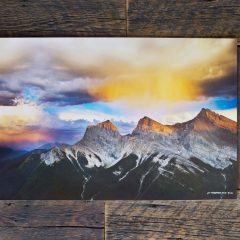Fine art photography (FAP) refers to photographs that are made in the creative vision of the photographer as an artist. Fine art photography generally stands in contrast to photojournalism, which is a visual account of news events or a record of things, places and people. Commercial photography, the primary focus of which is to advertise products or services, is generally held apart from fine art as well. That said in my experience the commercial and journalistic often slops over into fine art.
If one reviews the history of photography it quickly become clear that well made image narratives, produced for journalistic or commercial purposes, frequently become objects of art. Often but not always this transition takes place well after the journalistic or commercial significance has passed. If one examines the enduring images from the great photographic publications of the past, the truth of this can easily be verified. Today many truly great images can be seen on the web, produced from the present journalistic and commercial traditions.
I could find no generally accepted definition(s) of the terms “art photography”, “artistic photography” or “fine art photography. Definitions are found in articles, essays and reference books in all media forms. What seems to be lacking is the generally or universally accepted part. (see: Wikipedia-Fine-art photography for examples.)
The balance of this essay is more personal opinion dependent than academic. One significant difference between an artistic rendering and fine art is the level of emotion created by the image’s narrative. An artistic rendering, of a really great image. that is creatively presented is surely art. Fine art takes that rendering one or two steps further into an emotional place that transcends the propose or location. Art in general and fine art almost always has a transcendence or universality that just images can not quite match. Fine art melds together all the compositional, technical and transcendence qualities to give it and its narrative a true universality.
I have been at this photography business, all be it hesitantly at first, since I was 11, that is (58 years). Over that time I have made images for just about any purpose one can imagine. In my mind or better to my taste, I have created fine art works in most if not all of them. The exception is probably in the classification snapshots. Got a few really good ones but no true art. In attempting to create the best possible images, of what ever subject and purpose was holding my interest, I found my creative vision could often be satisfied. I should also note that while my vision was frequently satisfied, my technical competence or the limitations of the equipment of the day, did not always yield stellar results.
A truly artistic image, regardless of subject or purpose has the qualities, often intangible, of what I call fine art. I have some training and education in art history. I understand the principles of composition and most of the technical aspects of most, if not all art forms. Don’t misunderstand, I claim no pretense to full competence for any except photography.
As I Found It and Ideal Totem (my two stock photo services) hold well over 4,000 images (at the time of writing). A very high proportion of these stock images qualify as art. They are good and well presented, even the textures and patterns tell their story well. Some are probably even great. Perhaps not quite as many as my ego would like, but still a good number. None are true Fine Art.
A small percentage of my work has been selected to be offered as, highly limited, special fine art editions. These editions will be presented in physical format that has the same listing quality as the images themselves.
In a world of Fine Art images are often classified the same way as paintings. For example: Impressionism, Abstract, Realism and so on. Fine Art implies the imposition of the creative mind over reality except in the Realism school. Impressionism is more concerned with the spirit of a subject than accurate rendering. Abstraction realities on a different external world view often reducing the subject to geometric shapes, lines and zone of color.
The photographer can and does do this too. His tool box is different. Gone are brushes and palette knife. He substitutes one technology for another.
Digital based art and modern photography is that, has the potential to become over produced and ubiquitous. No matter how good a work is, if reality and uniqueness are not preserved then it becomes ordinary and cheep. The power or feeling created by the image as not been lost it is the commonality that causes it to become devalued.









